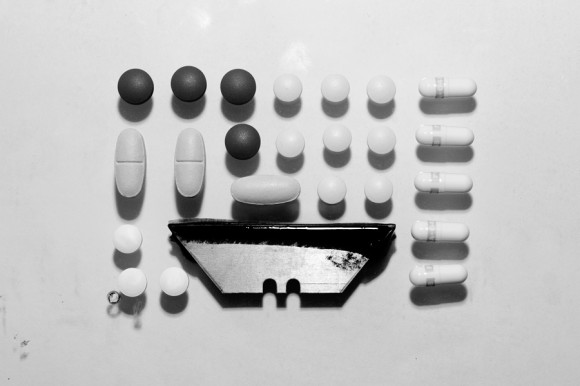I couldn’t understand why my brother, whose sole income was $600 and change a month from Social Security, would spend up to $300 at a time on plastic robots. They were delivered direct from Japan, plain cardboard packages concealing bright, shiny boxes covered in characters we couldn’t read. He would only buy Perfect Grade models, not the ones just anyone could assemble.
A new Gundam kit came in the mail. David cleared the kitchen table and emptied the box. The nascent model arrived in hundreds of pieces, rows and rows of bits of plastic attached to plastic frames. David clipped each piece from the frame, then sanded off the little nub left behind. He had to paint some pieces, and wired some of the models so their eyes would light up or their weapons would glow. David would snap the pieces together, carefully, so the finished model would be articulate at all the proper points. The models had layers, a robot skeleton with exoskeleton of armor.
I thought that was kind of silly. What did it matter what was underneath the exterior of a toy?
Once the model was assembled, it had to be detailed. This meant decals, which would end up with maddening air bubbles unless they were applied meticulously, but also things that never would have occurred to me, like inking over the seams with fine tip markers designed for that purpose.
David stayed all night working on the model and still took days to finish. Once he was done he had a plastic robot, eight to twelve inches tall. He showed me how it could move not just its arms and legs, but its torso, feet, and wrists, as well as that adjustable armor. Then it went on the shelf with the others, one orderly shelf, an oasis in his filthy room. He didn’t play with them. Their purpose was the process.
I call David my ‘little’ brother to be ironic. He’s 6’4” and over four hundred pounds. David’s younger than me, but not by much. We were born thirteen months apart, almost Irish twins, meaning I can’t remember a life without him.
We’ve always been close, but we’re not alike. He lives in a different world than me, and that predates his schizophrenia. Long before the onset of his illness he related to our surroundings differently. He looked at things and could figure out how they worked, or he would take them apart. He’d be able to put them together again, and after that he’d know how to fix them if they ever broke.
We were kids, in middle school maybe, when David took apart my tape deck. Broke it down to pieces of gray plastic and metal, its raw unrecognizable components.
I wasn’t pleased.
But he’s unflappable. He didn’t fuss or apologize. He put it back together. And it worked just fine.
People make a fuss over Zeus, the king of the gods, and I’ll admit that hurling lightening bolts is impressive, but it was Hephaestus who made the throne Zeus sat on. While Zeus was off gallivanting, turning into a swan to rape Leda, it was Hephaestus who forged armor for the gods. Everyone else on Mount Olympus was scheming and trysting. Hephaestus made things.
David is the Hephaestus of our family. David has always been the one that builds and repairs. Without him we’re helpless. David, how do I hook up my computer? David, the toilet’s broken. David, how do I turn on the TV? It’s on, but the screen is blank. Where are the moving pictures?
The ability to assemble and deconstruct, create and destroy, can’t be separated. When your insurance policy mentions an ‘act of God’ it isn’t talking about a miracle. Something has been decimated. In Hinduism the mother goddess, Kali, sits at the edge of the universe, devouring time. In paintings she’s depicted wearing a garland of human heads.
And David has excelled at destruction.
As a child he went out to the garage, found a crowbar, and tore down a sizable section of the drywall divider between the workshop and carport. That didn’t go over well. But he didn’t do it in a rage. He was just curious.
I never thought of David as someone with a temper. It’s more like a law of physics: when he’s pushed there will be an equal and opposite reaction. David once told our parents he broke his hand hitting his locker, but he told me the truth. A kid at the park made fun of him for being fat. He punched the kid in the face and it broke his hand.
I saw his mangled hand after, and then the x-ray. One of his metacarpals was cracked clean in two. The jagged edges of bone were at an angle, like a broken stick. Imagine being strong enough to break your own hand. And I’ve taken advantage of that too. David, would you open this can for me? David, could you help me move? It’s a fourth floor walk-up.
For a long time, I didn’t worry about him because he was strong and handy and capable of things I wasn’t. I was away when he started cutting himself. I couldn’t make sense of it.
It looked like he’d been mauled by a jungle cat. More accurately, it looked like he’d been violently attacked by a savage teenager with a sharp knife, repeatedly, over several months.
He’s never been able to say why he did it, and it hasn’t happened in years. For a long time there was nothing we could do to stop him. He went to therapists, psychiatrists, and did some stints in mental hospitals. They put him on drugs that left him completely blank, drugs that didn’t just subtract his personality, but added pounds, weight that increased exponentially.
There are lots of reasons people cut themselves. For attention or to feel something, or because what they’re already feeling is so terrible that they need a different pain, a distraction. I don’t think it was any of those things for David.
His cuts were too probing. He cut deep into the subcutaneous fat. My mom would have to take him to the ER. He’d leave bloody handprints in the bathroom.
I think that he started cutting himself because of the hallucinations. Schizophrenia isn’t like dementia, a gradual unmooring and then a slow drift away from reality. It’s more like a car accident, the sort of thing that can happen to anyone, anytime. We were blindsided.
When David was sixteen it just happened. Some of the things he saw and heard were real and some of them weren’t. Some of his memories were false. Out of nowhere he was a mystery to himself and he couldn’t trust his perceptions. What did he do when he needed to find out how something worked? He took it apart and looked inside.
Like the essay? Check out our print issue.
Read more about Katheryn here.
Read more about Justin here.






















Thank you for sharing this story.
The story leaves me asking how is David now?
I’m happy to say that although David is still on full disability, he’s doing really well. He hasn’t had any psychotic episodes or cut himself in years. He, our older brother, and myself remain very close. We hang out a couple times a week. David is really interested in photography, and he’s the one who took my bio photo.
Kate this writing surprised me. I like its clarity. I like its heart. Your writing held a challenging balance between enough sympathy and too much. By the end, I love david. I love the taking apart and putting back together. And I cringed at his need to look inside and his solution for accomplishing that. It’s a lovely talent you have.
Kate,
I really enjoyed this essay. I’d like to use it in my 9th grade class, if that’s all right with you, as an example of a personal essay. It has the right balance of narrative and reflection that I think will appeal to my students and get them writing.
Terrific ending, too, and the message is thought-provoking.